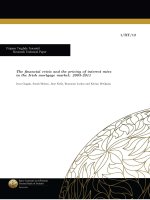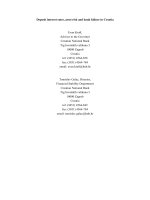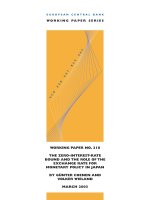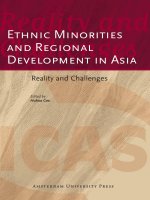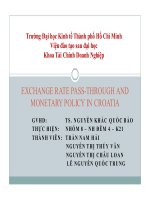exchange rates, currency crisis and monetary cooperation in asia (2009)
Bạn đang xem bản rút gọn của tài liệu. Xem và tải ngay bản đầy đủ của tài liệu tại đây (1.74 MB, 263 trang )
Exchange Rates, Currency Crisis and
Monetary Cooperation in Asia
9780230_577053_01_prexx.indd i 3/4/2009 4:45:20 PM
Also by Ramkishen S. Rajan:
Authored / Co-authored:
SINGAPORE’S TRADE AND INVESTMENT PERFORMANCE AND POLICIES
(with Shandre Thangavelu), 2009.
EXCHANGE RATE REGIMES, AND MACROECONOMIC MANAGEMENT IN
ASIA (with Tony Cavoli), 2009.
ASIA IN THE GLOBAL ECONOMY: FINANCE, TRADE AND INVESTMENT (with
Sunil Rongala), 2007.
ECONOMIC GLOBALIZATION AND ASIA: ESSAYS ON FINANCE, TRADE AND
TAXATION, 2003.
SINGAPORE’S ATTRACTION TO FREE TRADE AREAS: BILATERAL TRADE
RELATIONS WITH JAPAN AND THE US (with Rahul Sen and Reza Siregar),
2001.
Edited / Co-edited:
PRINCETON ENCYCLOPEDIA OF THE WORLD ECONOMY (with Kenneth
Reinert as co-editor and Lewis Davis and Amy Glass as associate editors), 2008
MONETARY, EXCHANGE RATE AND FINANCIAL ISSUES AND POLICIES IN
ASIA (with Shandre Thangavelu and Rasyad Parinduri), 2008.
INTRA ASIAN FDI FLOWS: MAGNITUDE, TRENDS, PROSPECTS AND POLICY
IMPLICATIONS (with Rajiv Kumar and Nicola Virgill), 2008.
MANAGING GLOBALISATION: LESSONS FROM CHINA AND INDIA (with
David Kelly and Gillian Goh), 2006.
SUSTAINING COMPETITIVENESS IN THE NEW GLOBAL ECONOMY: THE
EXPERIENCE OF SINGAPORE, 2003.
9780230_577053_01_prexx.indd ii 3/4/2009 4:45:20 PM
Exchange Rates, Currency
Crisis and Monetary
Cooperation in Asia
Written and Edited by
Ramkishen S. Rajan
Associate Professor, School of Public Policy, George Mason University, USA
9780230_577053_01_prexx.indd iii 3/4/2009 4:45:20 PM
Introduction, selection and editorial matter © Ramkishen S. Rajan 2009
Individual chapters © contributors 2009
All rights reserved. No reproduction, copy or transmission of this
publication may be made without written permission.
No portion of this publication may be reproduced, copied or transmitted
save with written permission or in accordance with the provisions of the
Copyright, Designs and Patents Act 1988, or under the terms of any licence
permitting limited copying issued by the Copyright Licensing Agency,
Saffron House, 6-10 Kirby Street, London EC1N 8TS.
Any person who does any unauthorized act in relation to this publication
may be liable to criminal prosecution and civil claims for damages.
The authors have asserted their rights to be identified as the authors of
this work in accordance with the Copyright, Designs and Patents Act 1988.
First published 2009 by
PALGRAVE MACMILLAN
Palgrave Macmillan in the UK is an imprint of Macmillan Publishers Limited,
registered in England, company number 785998, of Houndmills,
Basingstoke, Hampshire RG21 6XS.
Palgrave Macmillan in the US is a division of St Martin's Press LLC,
175 Fifth Avenue, New York, NY 10010.
Palgrave Macmillan is the global academic imprint of the above companies
and has companies and representatives throughout the world.
Palgrave® and Macmillan® are registered trademarks in the United States,
the United Kingdom, Europe and other countries.
ISBN-13: 978–0–230–57705–3 hardback
ISBN-10: 0–230–57705–9 hardback
This book is printed on paper suitable for recycling and made from fully
managed and sustained forest sources. Logging, pulping and manufacturing
processes are expected to conform to the environmental regulations of the
country of origin.
A catalogue record for this book is available from the British Library.
Library of Congress Cataloging-in-Publication Data
Exchange rates, currency crisis and monetary cooperation in Asia /
edited by Ramkishen S. Rajan.
p. cm.
Includes bibliographical references and index.
ISBN 978–0–230–57705–3
1. Foreign exchange rates—Asia. 2. Currency crises—Asia.
3. Monetary policy—Asia. 4. Finance—Asia. I. Rajan, Ramkishen S.
HG3968.E946 2009
332.4Ј95—dc22 2008052859
10 9 8 7 6 5 4 3 2 1
18 17 16 15 14 13 12 11 10 09
Printed and bound in Great Britain by
CPI Antony Rowe, Chippenham and Eastbourne
9780230_577053_01_prexx.indd iv 3/4/2009 4:45:21 PM
Dedicated to my team:
Harminder and Shreyas Rajan
9780230_577053_01_prexx.indd v 3/4/2009 4:45:21 PM
This page intentionally left blank
vii
Contents
List of Figures and Box ix
List of Tables xi
Acknowledgments xiii
Notes on Contributors xiv
Introduction xv
Part I Exchange Rates and Macroeconomic Consequences
1 Managing the Liquidity Effects of
Reserve Stockpiling in Emerging Asia 3
(Co-authored with Alice Y. Ouyang and Thomas D. Willett)
2 What is the Impact of Exchange Rate Changes on
Inflation in Asia? 39
(Co-authored with Amit Ghosh)
3 A Closer Examination of Exchange Rate Pass-through in
Korea and Thailand 60
(Co-authored with Amit Ghosh)
Part II Impact of Currency Crisis and Monetary Policy
4 Are Crisis-Induced Devaluations Contractionary? If So,Why? 89
(Co-authored with Shen Chung-Hua)
5 Financial Crisis, Capital Outflows and Monetary Policy
Responses: Simple Analytics with Reference to East Asia 110
Ramkishen S. Rajan
6 Understanding Currency Crises and
Monetary Policy Responses in Emerging Economies 134
(Co-authored with Makarand Parulkar)
7 How Best to Manage New-Style Currency Crises? 151
Ramkishen S. Rajan
8 Can High Reserves Offset Weak Fundamentals? 180
(Co-authored with Jie Li)
9780230_577053_01_prexx.indd vii 3/4/2009 4:45:21 PM
viii Contents
Part III Monetary and Financial Cooperation in Asia
9 Examining the Case for an Asian Reserve Pool 193
(Co-authored with Reza Siregar and Graham Bird)
10 Taking Stock of Monetary and
Financial Cooperation in Asia 215
Ramkishen S. Rajan
11 Is There a Role for an Asian Currency Unit? 227
(Co-authored with Victor Pontines)
Index 239
9780230_577053_01_prexx.indd viii 3/4/2009 4:45:21 PM
ix
Figures and Box
1.1 International reserve holdings in emerging Asia
(including gold), 1990–2005 (US$ Billions) 4
1.2 NDA, NFA, Monetary base and money multipliers in
emerging Asia, 1990:q1–2005:q1 (US$ Billions) 11
1.3 Recursive estimated offset coefficients
(Based on perfect foresight model with random effects) 29
1.4 Recursive estimated sterilization coefficients
(Based on perfect foresight model with random effects) 30
3.1(a) Recursive estimates of ERPT elasticities of
Won–USD into Korea’s import prices 74
3.1(b) Recursive estimates of ERPT elasticities of
Won–USD into Korea’s CPI 74
3.1(c) Recursive estimates of ERPT elasticities of
Won–Yen into Korea’s import prices 75
3.1(d) Recursive estimates of ERPT elasticities of
Won–Yen into Korea’s CPI 75
3.1(e) Recursive estimates of ERPT elasticities of
NEER into Korea’s import prices 76
3.1(f) Recursive estimates of ERPT elasticities of
NEER into Korea’s CPI 76
3.2(a) Recursive estimates of ERPT elasticities of
Baht–USD into Thailand’s import prices 77
3.2(b) Recursive estimates of ERPT elasticities of
Baht–USD into Thailand’s CPI 78
3.2(c) Recursive estimates of ERPT elasticities of
Baht–Yen into Thailand’s import prices 78
3.2(d) Recursive estimates of ERPT elasticities of
Baht–Yen into Thailand’s CPI 79
3.2(e) Recursive estimates of ERPT elasticities of
NEER into Thailand’s import prices 79
3.2(f) Recursive estimates of ERPT elasticities of
NEER into Thailand’s CPI 80
5.1 Impact of crisis of confidence 112
5.2 The “do nothing” option 113
5.3 Liquidity infusion into Thai financial system 115
5.4 Foreign exchange reserve holdings in East Asia 116
5.5 Current account balances as a proportion of GDP in
East Asia (percentage) 117
5.6 Trends in monetary base in East Asia 118
5.7 Exchange rate depreciation: conventional expansionary effects 119
5.8 Exchange rate depreciation: perverse contractionary effects 120
5.9 GDP growth rate (percentage) 121
5.10 Impact of interest rate hike 123
9780230_577053_01_prexx.indd ix 3/4/2009 4:45:22 PM
x Figures and Box
5.11 Growth in broad money supply (M2) (percentage) 124
5.12 Three-month interbank lending rate in East Asia (percentage) 125
5.13 Bilateral nominal exchange rate: Rupiah per US Dollar 126
6.1 Real sector shock with positively sloped W curve 138
6.2 Real sector shock with negatively sloped W curve 142
6.3 Monetary policy contraction with upward sloping W curve 143
6.4 Monetary policy expansion with upward sloping W curve 144
6.5a Monetary policy contraction with downward sloping W curve 144
6.5b Monetary policy contraction with downward sloping W curve 145
6.6a Monetary policy expansion with downward sloping W curve 145
6.6b Monetary policy expansion with downward sloping W curve 146
7.1a Four quadrants of the conventional Swan diagram 154
7.1b Four quadrants of the new-style Swan diagram 158
7.2 Crisis management following an
adverse risk premium shock: case 1a 164
7.3 Crisis management following an
adverse risk premium shock: case 1b 165
7.4 Crisis management following an
adverse risk premium shock: case 1c 165
7.5 Crisis management following an
adverse export shock: case 2a 167
7.6 Crisis management following an
adverse export shock: case 2b 167
7.7 Crisis management following an
adverse export shock: case 2c 168
7.8 Crisis management following adverse risk premium shock:
multiple equilibria case 169
8.1 International reserves in Asia, 1990–2004 181
8.2 Reserves insufficient to offset weak fundamentals 185
8.3 Worsening fundamentals compensated for by higher reserves 186
9.1 Determining the optimal reserve holding 196
Box
6.1 Summary of appropriate monetary policy responses 146
9780230_577053_01_prexx.indd x 3/4/2009 4:45:22 PM
xi
Tables
1.1 De facto IMF exchange rate classifications, 1998–2004 5
1.2 Sources of reserve accumulation in emerging Asia,
1995–2005 (US$ Billions) 7
1.3 Definitions and measurement of
the variables used in empirical study 19
1.4a Unit-root test (ADF test): Pre-crises period
(1990:q1–1997:q1) 22
1.4b Unit-root test (ADF test): Post-crises period
(1998:q3–2005:q3) 22
1.5 Simple correlations between actual and
adjusted ΔNFA and ΔNDA 23
1.6 Hausman test 24
1.7 Panel data with random effects estimation,
1990:q1–1997:q1 and 1998:q3–2005:q3 25
1.8 Chow breakpoint test (H
0
: No Structural change),
pre- and post-crises periods 28
3.1 Highlights of inflation targeting regimes in
Korea and Thailand 61
3.2(a) Unit root test results 64
3.2(b) Cointegration test results 65
3.3(a) Dynamic OLS (DOLS)—import price ERPT for Korea 66
3.3(b) Dynamic OLS (DOLS)—import price ERPT for Thailand 67
3.4(a) Dynamic OLS (DOLS)—CPI ERPT for Korea 70
3.4(b) Dynamic OLS (DOLS)—CPI ERPT for Thailand 71
3.5(a) Effect of macro variables on ERPT elasticities into
import prices 82
3.5(b) Effect of macro variables on ERPT elasticities into CPI 83
4.1 Country information: average GDP growth and
proxies for the five hypotheses 98
4.2 Contractionary depreciation during currency crisis 99
4.3 Testing the five hypotheses of
output contraction during currency crisis 101
4.4 Testing the five hypotheses of
output contraction during successful attack 103
5.1 Thailand: composition of net private capital inflows
(US$ billions), 1997–1999 123
9780230_577053_01_prexx.indd xi 3/4/2009 4:45:22 PM
xii Tables
7.1 Optimal monetary and exchange rate policy mix 168
9.1 Reserves as proportion of imports (months),
GDP (in percent) and average amount
(in US$ millions) (1992–2004) 200
9.2a Reserve–Import ratio with and without pooling
(ASEAN-5) + Korea + China + Hong Kong +
Japan (1990–1998) 201
9.2b Actual reserve, hypothetical reserve and
fiscal cost (1990–1998) 203
9.3 Average and variability of the foreign
exchange reserves
(q4:1993–q1:2002) 206
9.4 Coverage with and without pooling for ASEAN-5,
Korea, Japan, China and Hong Kong (q4:1993–q1:2002)
207
9.5 Reserve gains and losses with the pooling scheme
(q4:1993–q1:2002) 208
11.1 Optimal basket weights for various groupings of
regional basket currencies,
January 2000–June 2007 (in percent) 233
9780230_577053_01_prexx.indd xii 3/4/2009 4:45:22 PM
xiii
Acknowledgments
Many of the chapters in this book are based on co-authored papers with
my colleagues in different parts of the world. I have learned a great deal
from collaborating with them and am grateful for their inputs and
cooperation. In particular, I would like to thank the following individu-
als: Alice Ouyang and Tom Willett (Chapter 1), Amit Ghosh (Chapters 2
and 3), Shen Chung-Hua (Chapter 4), Makarand Paraulkar (Chapter 6),
Jie Li (Chapter 8), Graham Bird and Reza Siregar (Chapter 9) and Victor
Pointines (Chapter 11). Many of the chapters were completed while I
visited various institutes and universities in the Asia-Pacific, most nota-
bly the Asian Development Bank in Manila, the Asian Development
Bank Institute in Tokyo, the Hong Kong Institute for Monetary Research,
the National University of Singapore (NUS), and the University of
Adelaide in Australia. I would like to acknowledge with gratitude but
without attribution the support and resources provided to me at these
institutions. I would also like to place on record the support of my col-
leagues and resources provided in my current place of employment, the
School of Public Policy at George Mason University (SPP-GMU) in
Virginia, USA. Needless to say, the views expressed in this volume are
personal, and in particular I am solely responsible for any errors.
I would like to thank the various journal editors and publishers who
kindly allowed my articles to be reprinted in this book.
Lastly, but most importantly, my family members have remained
unstinting in their support of my career and provided me the stability
necessary to remain focused on my writings.
R
AMKISHEN S. RAJAN
School of Public Policy
George Mason University
Arlington, Virginia
USA
October 2008
9780230_577053_01_prexx.indd xiii 3/4/2009 4:45:22 PM
xiv
Contributors
Graham Bird is Professor at the Department of Economics and Director
of the Surrey Centre for International Economics Studies (SCIES) of the
University of Surrey, Guildford, UK.
Amit Ghosh is Assistant Professor at the Department of Economics of
Illinois Wesleyan University, Bloomington, Illinois, USA.
Jie Li is Assistant Professor at the Central University of Finance and
Economics and Director of the CUFE Research Center for Foreign
Reserves, Beijing, China.
Alice Y. Ouyang is Assistant Professor at the China Academy of Public
Finance and Public Policy of the Central University of Finance and
Economics, Beijing, China.
Makarand Parulkar is Deputy Chief Operating Officer at Bradford
College of the University of Adelaide, Adelaide, Australia.
Victor Pontines is Lecturer of Economics and Public Policy at Carnegie
Mellon University H. John Heinz III School of Public Policy and
Management, Adelaide, Australia.
Chung-Hua Shen is a Professor at the Department of Finance of National
Taiwan University, Taipei, Taiwan.
Reza Siregar is International Economic Consultant at the International
Monetary Fund—Singapore Regional Training Institute, Singapore.
Thomas D. Willett is Director of the Claremont Institute for Economic
Policy Studies and Horton Professor at the School of Politics and
Economics of Claremont Graduate University, Claremont, California,
USA.
9780230_577053_01_prexx.indd xiv 3/4/2009 4:45:22 PM
xv
Introduction
Prior to the Asian financial crisis of 1997–1998, scant attention was paid
by policymakers to monetary and financial issues. The predominant
focus then was on the real side of the economy (trade and develop-
ment). The crisis and its aftermath quickly shifted attention to and
interest in concerns about currency crises and exchange rate move-
ments in an era of rapid global capital flows. Given the high degree of
economic openness in the region and its consequent heavy dependence
on trade and investment, the Asian economies are especially susceptible
to shifts in global capital flows and sharp exchange rate movements.
While many Asian economies have taken a number of steps individu-
ally to fortify themselves against future external shocks, they have, as a
group, simultaneously initiated a slow but steady process of enhancing
mone tary and financial cooperation. Since the region holds the largest
reserves in the world and consequently plays a significant role in the
global macroeconomic imbalances, Asian monetary and financial issues
have clearly taken on global importance. The collection of chapters in
this volume therefore attempts to explore various aspects of monetary,
exchange rate and financial issues in Asia.
1
The book is truly pan-Asia-focused with chapters on China, Japan,
Korea, India and Southeast Asia. The chapters are focused on important
policy issues of contemporary relevance, but are informed by analytical
frameworks, data and empirics. While the chapters have been written
in a manner that is able to stand up to academic scrutiny,
2
they are also
meant to be accessible to policymakers, researchers and financial jour-
nalists who might be interested in Asian monetary, exchange rate and
financial issues, concerns and policies.
The book concentrates on three broad themes, viz. exchange rates
and their macroeconomic consequences in Asia; analytical and empir-
ical issues relating to currency crises and policy responses with refer-
ence to Asia; and monetary and financial cooperation in Asia. Below is
a summary of each of the eleven chapters.
The first three chapters in Part I deal with the inflationary conse-
quences of exchange rate movements and exchange rate interventions
in Asia.
Chapter 1 is entitled “Managing the Liquidity Effects of Reserve
Stockpiling in Emerging Asia.” The huge increase in international
9780230_577053_01_prexx.indd xv 3/4/2009 4:45:22 PM
xvi Introduction
reserve holdings by Asian countries since the 1997 crisis has been one
of the most important recent developments on the international finan-
cial scene. These buildups have contributed substantially to concerns
about the creation of excessive global liquidity. How justified these con-
cerns are would depend considerably on the extent to which the reserve
accumulating countries have been able to mop up or sterilize its effects
on their domestic monetary aggregates. This chapter uses a unified the-
oretical framework to undertake dynamic estimations of the magnitude
of sterilization and offset coefficients (which measure the degree of cap-
ital mobility) for a large set of Asian economies. Empirical findings sug-
gest that, despite substantial capital mobility, there has been a high
degree of effective sterilization to date.
Chapter 2 is entitled “What is the Impact of Exchange Rate Changes
on Inflation in Asia?” An important but age-old transmission channel
of global factors into domestic prices is via exchange rate movements,
so-called exchange rate pass-through (ERPT). It is generally believed
that Asian economies are potentially susceptible to the inflationary
effects of exchange rate changes since they are highly trade-dependent.
This chapter explores this issue, paying particular attention to produc-
tion sharing—a key characteristic of Asian trade—and its implications
for the inflationary consequences of exchange rate movements.
Chapter 3 is entitled “A Closer Examination of Exchange Rate Pass-
through in Korea and Thailand.” This chapter examines the extent and
evolution of ERPT into Korea’s and Thailand’s consumer and import
prices at the aggregate level for the period over the last two decades.
Results suggest that ERPT is consistently higher for Thailand as com-
pared with Korea; while for both nations the ERPT of their respective
bilateral rates with respect to the US dollar is higher than with respect
to the Japanese yen. The chapter also investigates whether and how
ERPT has changed in these two economies over time, especially during
and after the currency crisis period of 1997–1998.
The next five chapters in Part II deal with analytical and policy
issues relating to financial crises in emerging economies, with par-
ticular reference to Asia.
Chapter 4 is entitled “Are Crisis-Induced Devaluations Contractionary?
If so, Why?” Why are some currency crises followed by economic con-
tractions while others are not? This chapter is an attempt at answering
this query. In particular, the chapter investigates two closely-related
questions. First, is there is a difference in the output effects of a devalu-
ation during “normal” periods as against those during crisis periods?
After all, during non-crisis periods, real exchange devaluation is seen as
9780230_577053_01_prexx.indd xvi 3/4/2009 4:45:22 PM
Introduction xvii
an important policy option for promoting exports and output growth.
Yet, the literature has not made a distinction between crisis and non-
crisis periods. To preview the main conclusion, results indicate that the
contractionary effects tend to exist only during the crisis period.
Building on this, the chapter goes on to explore the factors that cause a
crisis-induced devaluation to be contractionary.
Chapter 5 is entitled “Financial Crisis, Capital Outflows and Monetary
Policy Responses: Simple Analytics with Reference to East Asia.”
Financial crises seem to have become the norm rather than the excep-
tion since 1992. This chapter examines the impact of a crisis of confi-
dence and resultant capital outflows from a small and open economy,
and the possible policy options in response to such outflows using sim-
ple tools and definitions that will be familiar to any money and bank-
ing or intermediate macroeconomics student. To facilitate the discussion,
examples are drawn from the East Asian crisis of 1997–1998 (Indonesia,
Korea, Malaysia and Thailand), although the analysis remains pertinent
to emerging economies in general.
Chapter 6 is entitled “Understanding Currency Crises and Monetary
Policy Responses in Emerging Economies.” When analyzing the appro-
priate response for monetary policy during a currency crisis, it is impor-
tant to keep in mind two distinct channels: the effect of raising interest
rates on exchange rates and the direct effect of exchange rate changes
on output. The first pertains to the monetary side of the economy as
given by the interest parity condition. The second deals with the real
side of the economy. The interaction between these two parts of the
economy derives the equilibrium output and exchange rate in the econ-
omy. This chapter expands the Aghion et al. (2000) monetary model
with nominal rigidities and foreign currency debt to examine the inter-
action between the real and monetary sides of the economy and to ana-
lyze the effect of monetary policy on the real economy. We find that the
effect of monetary policy on exchange rate and output is theoretically
ambiguous. This in turn suggests that the appropriate monetary policy
response could vary among countries at any point in time, or for a par-
ticular country between two different periods.
Chapter 7 is entitled “How Best to Manage New Style Currency
Crises?” The new-style currency crises that have affected a number of
developing and emerging economies of late are characterized by “sud-
den stops” in capital inflows and adverse balance sheet effects. Given
the potential high costs of these crises, there is an ongoing debate on
how best they might be managed when they do arise. This chapter
argues that the time-honored Swan diagram, appropriately modified, is
9780230_577053_01_prexx.indd xvii 3/4/2009 4:45:23 PM
xviii Introduction
able to provide useful insights into how a country might manage a new-
style crisis through a combination of adjustment (which involves
expenditure switching and reducing polices) and financing.
Chapter 8 is entitled “Can High Reserves Offset Weak Fundamentals?”
While the previous chapter focused on crisis management, this chapter
concentrates on crisis prevention and the role of international reserves in
staving off a future crisis. In particular it develops a simple optimizing
model to determine the optimal reserve holdings by a country looking to
minimize the net costs of holding reserves. In so doing it attempts to
determine the validity of the assertion that is sometimes made that suffi-
ciently high levels of reserves can compensate for weak fundamentals.
Ever since the currency crisis of 1997–1998, there has been a great
deal of interest in enhancing regional economic cooperation in Asia.
The last three chapters in Part III tackle selected issues on Asian monet-
ary and financial cooperation.
Chapter 9 is entitled “Examining the Case for an Asian Reserve Pool.”
As noted previously, many Asian economies are stockpiling reserves as
a means of self-insurance against future crises. Holding such large vol-
umes of reserves is costly but it also suggests that the regional econ-
omies have the capacity to develop a common reserve pool arrangement.
This chapter investigates the gains, if any, to be reaped if East Asian
economies were to pool their reserves. It also briefly discusses how the
proposed reserve pool would fit into the larger context of evolving East
Asian monetary regionalism.
Chapter 10 is entitled “Taking Stock of Monetary and Financial
Cooperation in Asia.” It is important to keep in mind that economic
regionalism is multidimensional in nature. The focus of this chapter is
on policy initiatives underway in Asia to enhance monetary and finan-
cial regionalism and the analytical bases for these initiatives, rather
than on examining the de facto level of financial and monetary links
that already exist (which may or may not have been facilitated via
regional policy mechanisms). This chapter focuses more narrowly on
“medium forms” of monetary and financial regionalism, broadly
defined as the development of regional liquidity arrangements and
regional financial markets.
Chapter 11 is entitled “Is there a Role for an Asian Currency Unit?”
While most observers agree that the time is not yet ripe for Asia to con-
sider a common currency, there has been some discussion about the
possible creation of an Asian Currency Unit (ACU). This chapter exam-
ines the specific issue of the ACU which, in a general sense, is a weighted
average of regional currencies a la the European Currency Unit (ECU).
9780230_577053_01_prexx.indd xviii 3/4/2009 4:45:23 PM
Introduction xix
The chapter critically examines the rationale for the ACU proposal and
offers an initial attempt at computing optimal currency composition of
the ACU. The optimal basket weights computed are aimed at ensuring a
regional currency basket that has minimal variance. Hence it should
deliver stability in intraregional exchange rates for alternative configu-
rations of currency baskets in the Asian and Pacific region.
Notes
1. Issues that might be missing from this book such as the choice of exchange
rate regimes, inflation targeting, and dynamics of capital flows have been
explored in a companion volume (Cavoli and Rajan, 2009).
2. Indeed, a number of the chapters draw on and build upon papers published
in refereed journals.
References
Aghion, P., P. Bacchetta, and A. Banerjee (2000). “A Simple Model of Monetary
Policy and Currency Crises,” European Economic Review, 44, 728–738.
Cavoli, T. and R.S. Rajan (2009). Exchange Rate Regimes and Macroeconomic
Management in Asia, Hong Kong: Hong Kong University Press.
9780230_577053_01_prexx.indd xix 3/4/2009 4:45:23 PM
This page intentionally left blank
Part I
Exchange Rates and
Macroeconomic Consequences
9780230_577053_02_cha01.indd 1 2/13/2009 5:31:56 PM
This page intentionally left blank
3
1.1 Introduction
Asia accounted for over half of global international reserve holdings during
the period 1999–2005, up from one-third in the period 1990–1995 (Kharas
et al. 2006).
2
While China and Japan have been the main drivers of the mas-
sive stockpiling of reserves in the region, India, Hong Kong, Korea, Singapore
and Taiwan, and some middle-income Southeast Asian economies have also
experienced significant swelling of their reserves since the crises (Figure 1.1).
For Korea and other regional economies that were hit by the regional
crisis, policymakers appear to have deliberately chosen to amass high lev-
els of reserves for precautionary or self-insurance motives against future
financial crises (Aizenman and Marion 2003; Bird and Rajan 2003; also
see Chapter 8 of this volume).
3
Reserve accretion as a financial safeguard
is consistent with modern second generation (escape clause-based) cur-
rency crises models a la Obstfeld (1986, 1994).
4
However, many Asian
countries have continued accumulating reserves well beyond plausible
precautionary levels (also see Chapter 9 of this volume).
Some have argued that the reserve growth in emerging Asia more
recently is a by-product of a desire by central banks to smooth exchange
rate movements, but smoothing behavior by central banks should, in
general, have no net impact on reserves over time. The continued build-up
of reserves suggests that intervention is largely asymmetric and that it
stems largely from a desire to maintain relatively stable and/or “ultra-
competitive” exchange rates.
5
A number of commentators have expressed
concerns that such large-scale intervention runs a serious risk of gener-
ating increases in inflation in the intervening countries, and some have
even suggested that such reserve accumulations have played a major
role in the creation of excessive global liquidity. Key to such issues is
the extent to which monetary authorities can successfully sterilize the
1
Managing the Liquidity Effects of
Reserve Stockpiling in Emerging Asia
1
(Co-authored with Alice Y. Ouyang and Thomas D. Willett)
9780230_577053_02_cha01.indd 3 2/13/2009 5:31:57 PM
4 Co-authored with Alice Y. Ouyang and Thomas D. Willett
domestic monetary effects of reserve accumulation. Most monetary
models of the exchange rate and balance of payments assume no steril-
ization so that large reserve accumulations would automatically lead to
rapid growth in domestic money and credit. Sufficiently high levels of
international capital mobility would make effective sterilization impos-
sible, no matter the intensity of efforts of the domestic monetary author-
ities. In recent research Ouyang, Rajan, and Willett (2007) analyzed these
issues for China and found that it had been able to effectively sterilize a
high proportion of its recent reserve increases. China has substantial cap-
ital controls, however, so the People’s Bank of China’s ability to sterilize
would not necessarily carry over to the other Asian economies.
The aim of this chapter is to investigate the extent of monetary steriliza-
tion and the degree of capital mobility to eight Asian economies: ASEAN-4
(Indonesia, Malaysia, Philippines, Thailand), India, Korea, Singapore, and
Taiwan.
6
All these economies were impacted by the Asian crises of 1997–
1998. While Indonesia, Korea, Philippines and Thailand have all imple-
mented open economy inflation targeting regimes (open economy in the
sense of there being a role for exchange rate management as well), India,
Singapore and Taiwan operate managed floating regimes, a policy also
adopted by Malaysia since July 2005 (Table 1.1 and Rajan 2006).
7
0
100
200
300
400
500
600
700
800
900
1995 1996 1997 1998 1999 2000 2001 2002 2003 2004 2005
Billions (US$)
China Japan India HK
Taiwan Korea 10 ASEAN
Figure 1.1 International reserve holdings in emerging Asia (including gold),
1990–2005 (US$ Billions)
Source: Based on data from International Financial Statistics (IFS), except Taiwan. The data
from 1995–2004 for Taiwan is from AREMOS dataset which is published by Taiwan
Economic Data Center. The 2005 data for Taiwan is updated from Taiwan’s central bank
website.
9780230_577053_02_cha01.indd 4 2/13/2009 5:31:57 PM


